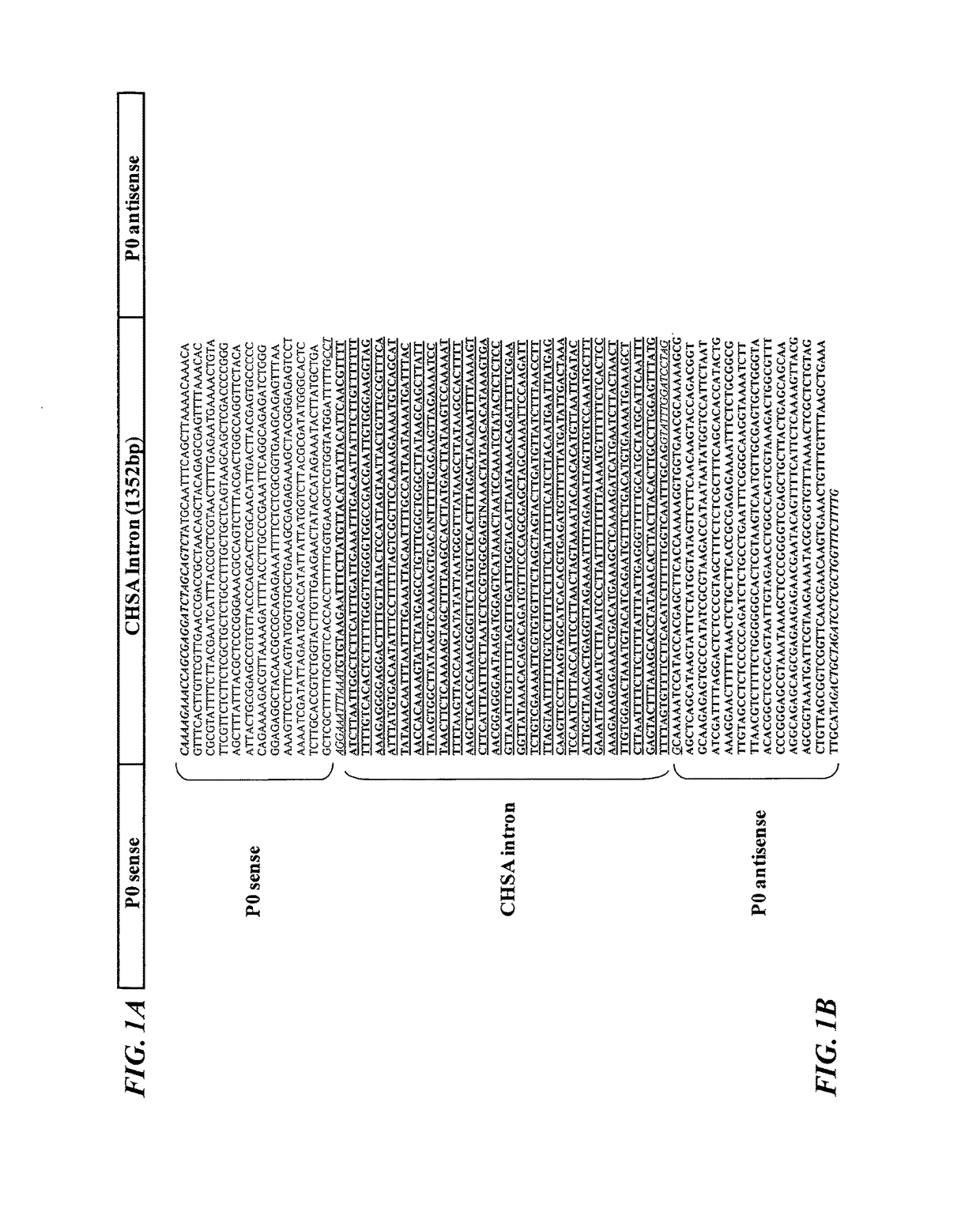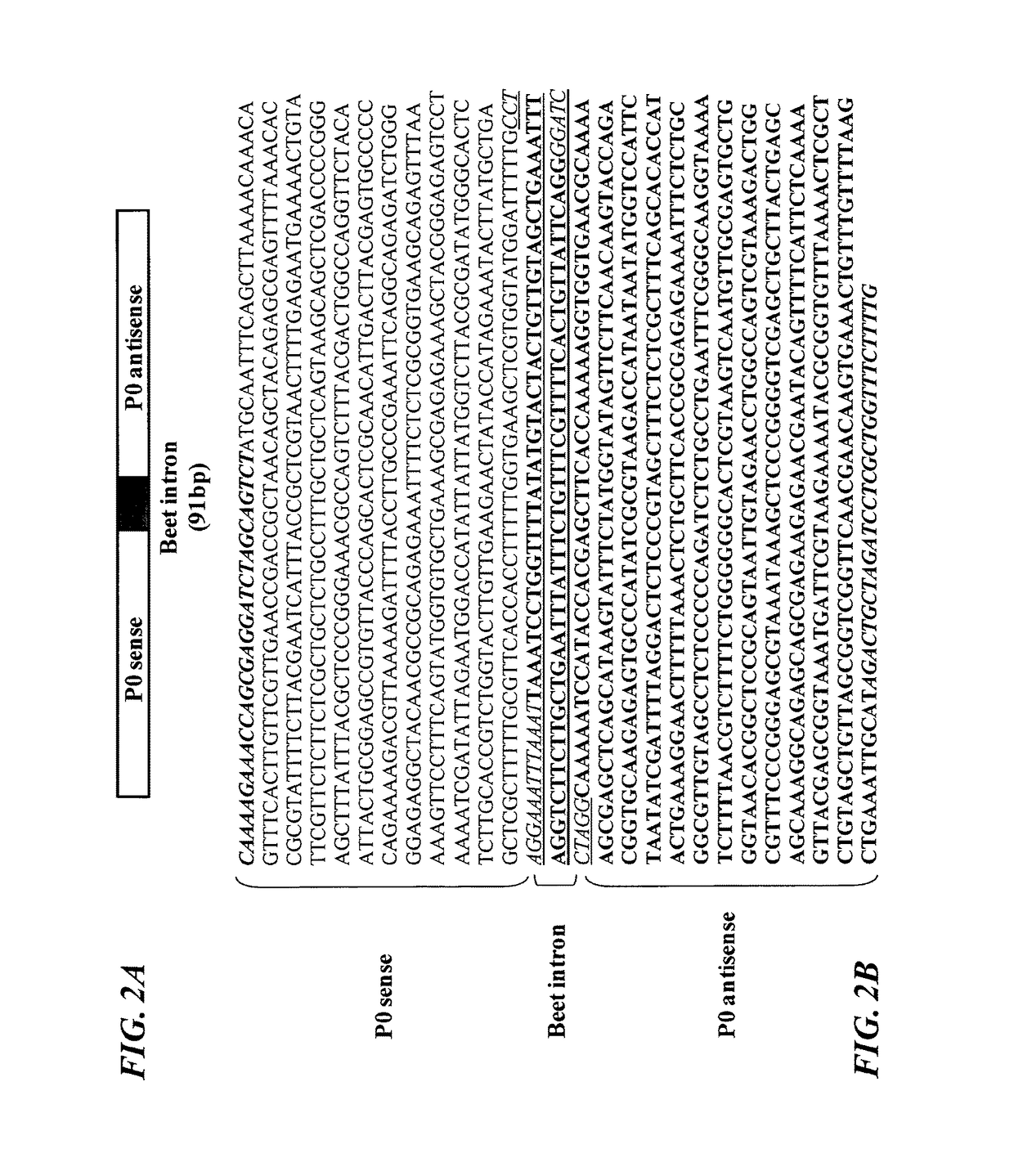P0 gene silencing constructs and use
a technology of p0 gene and construct, applied in the field of p0 gene silencing constructs and use, can solve the problems of large harvest loss, long time-consuming process, and long time-consuming to obtain useful resistant plants
- Summary
- Abstract
- Description
- Claims
- Application Information
AI Technical Summary
Benefits of technology
Problems solved by technology
Method used
Image
Examples
example 1
[0120]RNA silencing mechanism targets conserved sequences and induces their degradation. The most conserved sequences within Poleroviruses reside at the 3′ half of the RNA.
[0121]It is assumed that expression of the hairpin constructs having sequences deduced from conserved parts of the viral genome results (in planta) in the formation of dsRNA that is recognized and cut into duplexes of about 21-24 nts (siRNA) by the enzyme Dicer. Specific siRNAs will be loaded into a RISC complex (RNA induced silencing complex), that will on its turn target the homologous viral genomic RNA and induce degradation of the latter. As such, the virus metabolism will be severely impaired, and the symptoms of viral infection will be reduced. In the most favourable cases, total resistance will be obtained.
[0122]The inventors firstly generated two hairpins sequences derived from the viral 3′-end of the viral genome (BMYV).
[0123]The first construct harbored the CP (coat protein) sequence named hpCP and the s...
example 2
[0126]Transgenic Arabidopsis thaliana encoding hpP0(u) constructs according to the invention were then challenged with BMYV-2itb isolate.
[0127]Six independent transgenic Arabidopsis thaliana lines were created that express the hpP0 (or hp0u) mRNA. Results obtained with the construct 1 (FIG. 4A) are summarized in FIG. 5. The statistical ANOVA analysis performed revealed existing differences within ELISA values of transgenic and wild type plants (p<0.0001). Tukey test revealed the absence of significant difference between transgenic lines whereas all lines were significantly different to Col0 Inf (p<0.05) revealing the resistance of the transgenic lines toward BMYV inoculation.
[0128]P0-specific siRNA molecules were detected in the six lines but in higher levels in three resistant lines (hpP0-9, -10 and -12). No siRNA were detected in the susceptible plants (Col 0).
[0129]These results point out that hpP0(u) constructs are suitable to induce PTGS in Arabidopsis thaliana plants and can i...
example 3
[0130]The experiments from example 2 were repeated with the construct 2 (FIG. 4B) and with a higher number (eight) of transgenic Arabidopsis thaliana lines challenged with BMYV-2itb isolate.
[0131]The results are summarized in FIG. 6. For this construct, excepted line hpP0beet-3, all lines were resistant to BMYV as confirmed by ANOVA and Tukey statistical analysis (p<0.05). No significant difference was observed between hpP0-12 and resistant hpP0beet lines. P0-specific siRNA molecules levels were found to be significantly higher in the resistant lines (hpP0beet-1, -2, -5, -7 and -8) than in the other lines.
PUM
| Property | Measurement | Unit |
|---|---|---|
| size | aaaaa | aaaaa |
| resistance | aaaaa | aaaaa |
| viral resistance | aaaaa | aaaaa |
Abstract
Description
Claims
Application Information
 Login to View More
Login to View More - R&D
- Intellectual Property
- Life Sciences
- Materials
- Tech Scout
- Unparalleled Data Quality
- Higher Quality Content
- 60% Fewer Hallucinations
Browse by: Latest US Patents, China's latest patents, Technical Efficacy Thesaurus, Application Domain, Technology Topic, Popular Technical Reports.
© 2025 PatSnap. All rights reserved.Legal|Privacy policy|Modern Slavery Act Transparency Statement|Sitemap|About US| Contact US: help@patsnap.com



